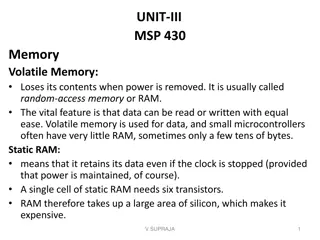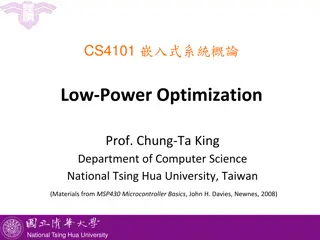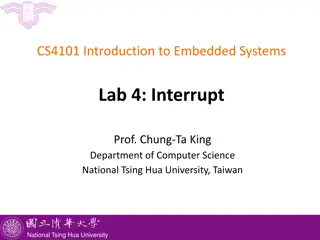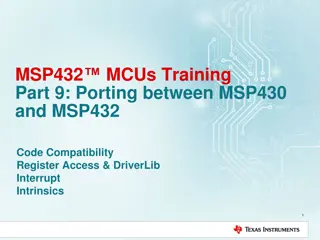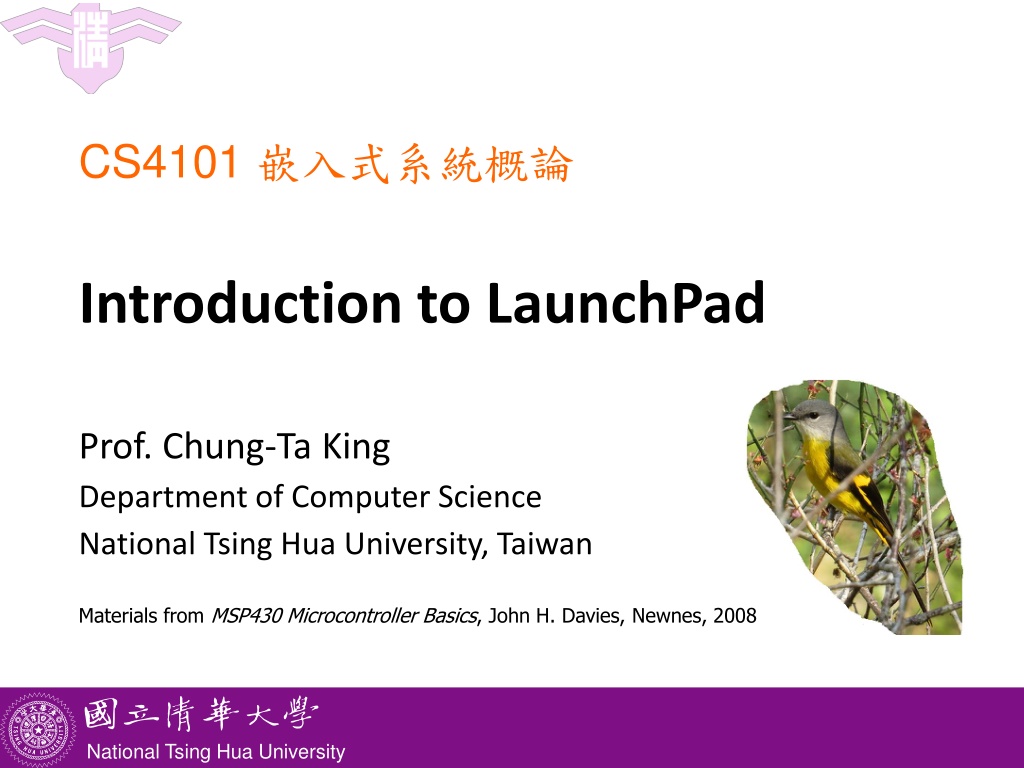
Exploring MSP430 Microcontroller Basics with LaunchPad Development Kit
Learn about the MSP430 LaunchPad development kit, which includes microcontrollers like MSP430G2553 and MSP430G2452. Understand the components of the MSP430 microcontroller, its features, and peripheral connections. Discover the inside and outside views of the MSP430G2553 microcontroller and its functionalities. Dive into programming the MSP430 using C and assembly languages in the LaunchPad development environment. Explore memory-mapped I/O and the usage of pins for digital input/output operations.
Download Presentation

Please find below an Image/Link to download the presentation.
The content on the website is provided AS IS for your information and personal use only. It may not be sold, licensed, or shared on other websites without obtaining consent from the author. Download presentation by click this link. If you encounter any issues during the download, it is possible that the publisher has removed the file from their server.
E N D
Presentation Transcript
CS4101 Introduction to LaunchPad Prof. Chung-Ta King Department of Computer Science National Tsing Hua University, Taiwan Materials from MSP430 Microcontroller Basics, John H. Davies, Newnes, 2008 National Tsing Hua University
Outline MSP430 LaunchPad MSP430 Microcontroller Processor Memory I/O First Program on LaunchPad C Assembly LaunchPad Development Environment 1 National Tsing Hua University
MSP430 LaunchPad Development Kit LaunchPad development board Mini-USB cable, 10-pin PCB connectors 2 MSP430 MCUs: MSP430G2553, MSP430G2452 Micro Crystal 32.768kHz Oscillator 2 National Tsing Hua University
MSP430 Microcontroller LaunchPad development board uses microcontroller such as MSP430G2553 and MSP430G2452 Microcontroller: A small computer on a single IC containing a processor core, memory, programmable I/O peripherals MSP430 microcontroller: Incorporates a 16-bit RISC CPU, peripherals, and a flexible clock system that are interconnected using a von- Neumann common memory address bus (MAB) and memory data bus (MDB) 3 National Tsing Hua University
MSP430 Microcontroller MSP430G2553 outside view (pin-out): 20-pin version VCC , VSS : supply voltage and ground P1.0~P1.7, P2.0~P2.7 are for digital input and output, grouped into ports P1 and P2 TA0CLK, TA0.0, and TA0.1 are associated with Timer0_A 4 National Tsing Hua University
MSP430 Microcontroller MSP430G2553 outside view: (cont d) A0~A7 inputs to the analog-to-digital (ADC) converter VREF is the reference voltage for the ADC converter ACLK and SMCLK are outputs for the microcontroller s clock signals UCA0RXD and UCA0TXD are used for the universal serial interface XIN and XOUT are the connections for a crystal RST is an active low reset signal NMI is the non-maskable interrupt input 5 National Tsing Hua University
MSP430G2553 Inside View LED P1OUT No P3 for 20-pin devices X P1IN P1REN MOV.W #0x100,P1OUT Memory- mapped I/O 6 National Tsing Hua University
MSP430 Instruction Set Instruction set architecture: RISC with 51 instructions, 3 formats, and 7 addressing modes 7 National Tsing Hua University
MSP430 CPU Registers Sixteen 16-bit registers R0, R1, R2, and R3: program counter, status registers, stack pointer, constant generator (provides six most used immediate values and reduces code size) R4 to R15 are working registers for general use 8 National Tsing Hua University
MSP430 Memory Organization Memory: Word and byte addressing and instruction formats 16-bit memory address bus (MAB) allows direct access and branching throughout entire memory range 16-bit memory data bus (MDB) allows direct manipulation of word-wide arguments Direct memory-to-memory transfers without intermediate register holding 9 National Tsing Hua University
MSP430 Memory Organization 16-bit addresses, addressing to bytes Aligned words: The address of a word is the address of the byte with the lower address, which must be even Little-endian ordering: The low-order byte is stored at the lower address and the high- order byte at the higher address 10 National Tsing Hua University
MSP430G2553 Memory Map Flash/ROM (16 KB) Flash/ROM (256 bytes) Information memory: A 256B block of flash memory that is intended for storage of nonvolatile data, including serial numbers to identify the equipment RAM (512 bytes) ? 11 National Tsing Hua University
MSP430 Input/Output Simple digital input and output of MSP430 (GPIO) takes place through sets of pins on the package of the IC called ports 20-pin MSP430G2553 has two ports: P1 (8 bits: P1.0~P1.7), P2 (8 bits: P2.0~P2.7) Typical pins can be configured for either input or output and some inputs may generate interrupts when the voltage on the pin changes The ports appear to the CPU as registers (memory- mapped I/O ),whereeach bit corresponds to a pin and a port may be associated to many registers for different purposes (next page) 12 National Tsing Hua University
Registers Associated with Port 1 Reg. Addr. Func. Description P1IN 020h Input from port 1 The 8 bits of data from port P1 P1OUT 021h Output to port 1 Outputs 8 bits of data to port P1 P1DIR 022h Direction of port 1 data transfer Bits written as 1 (0) configure corresponding pin for output (input) P1SEL 026h Select function for port 1 Bits written as 1 configure the corresponding pin for use by the specialized peripheral; 0 configure general-purpose I/O 13 National Tsing Hua University
Outline MSP430 LaunchPad MSP430 Microcontroller Processor Memory I/O First Program on LaunchPad C Assembly LaunchPad Development Environment 14 National Tsing Hua University
LaunchPad Development Board USB Emulator Connection Embedded Emulation 6-pin eZ430 Connector Crystal Pads Chip Pinouts Part and Socket Power Connector P1.3 Button LEDs and Jumpers P1.0 & P1.6 Reset Button 15 National Tsing Hua University
LaunchPad Pinouts On-board features of LaunchPad are pinned in the following fashion: LED1 (red) = P1.0 LED2 (green) = P1.6 Switch1 = P1.3 Switch2 = Reset Timer UART Transmit = P1.1 Timer UART Receive = P1.2 In order to blink the Red and Green LEDs, we have to set Ports 1.0 and 1.6 as outputs, and toggle them 16 National Tsing Hua University
Sample Code (msp430g2xx3_1.c) #include <msp430x2553.h> void main(void) { WDTCTL = WDTPW + WDTHOLD; // Stop watchdog timer P1DIR |= 0x41; // set P1.0 & P1.6 to outputs //(red & green LEDs) for(;;) { volatile unsigned int i; P1OUT ^= 0x41; // Toggle P1.0 & P1.6 with XOR i = 50000; // Delay do (i--); while (i != 0); } } 17 National Tsing Hua University
Sample Code (contd) Configure the LED connected to the GPIO line The green and red LED are located on Port 1 Bit 0 and Bit 6 make these pins to be output P1DIR set to 0x41 = 01000001 WDTCTL = WDTPW + WDTHOLD; // Stop watchdog timer P1DIR |= 0x41; // P1.0 & 6 outputs 0100 0001 To turn on/off LED, set bit in register to 1/0 Use XOR to toggle P1OUT P1OUT ^= 0x41; // toggle P1.0 & 6 on/off 18 National Tsing Hua University
Characteristics of Sample Code No printf(), no GUI operations Do not end Do I/O mainly More on control of peripherals through their special registers details of individual bits, bytes, words are important manipulations of bits, bytes, words Complete ownership of CPU No OS 19 National Tsing Hua University
Notes of Sample Code volatile variable: volatile unsigned int i; The variable may appear to change spontaneously, with no direct action by the user s program may be due to memory-mapped I/O devices Compiler must be careful in optimizing it Ex.: should not keep a copy of the variable in a register for efficiency; should not assume the variable remains constant when optimizing the structure of the program, e.g., rearranging loops The peripheral registers associated with the input ports should be declared as volatile 20 National Tsing Hua University
Notes of Sample Code Example from wikipedia: static int foo; void bar(void) { foo = 0; while (foo != 255) ; } Optimizing compiler will think that foo is never changed and will optimize the code into static int foo; void bar(void) { foo = 0; while (true) ; } The volatile keyword in declaration of foo prevents this optimization 21 National Tsing Hua University
Notes of Sample Code Bit manipulation: Important ISA feature for embedded processors Bit mask: set a bit P1OUT = P1OUT | BIT3 clear a bit P1OUT &= ~BIT3 toggle a bit P1OUT = BIT3 Bit field: struct { unsigned short TAIFG:1; unsigned short TAIE:2; unsigned short TACLR:5; } TACTL_bit; Setwith TACTL_bit.TAIFG = 1 22 National Tsing Hua University
Other Aspects of Embedded C Programs for small embedded systems tend not to contain a lot of complicated manipulation of complex data objects Much code is usually devoted to the control of peripherals through their special registers Details of individual bits, bytes, words are important Important operations Shifting and rotating bits Bit-level Boolean logic (A && B) and bitwise operator (A & B) Bit mask for testing and modifying individual bits 23 National Tsing Hua University
Other Aspects of Embedded C Union for manipulating individual bits or the whole byte/word as a unit union { unsigned short TACTL; // Timer_A Control struct { unsigned short TAIFG : 1; // Timer_A counter interrupt flag unsigned short TAIE : 1; // Timer_A counter interrupt enable unsigned short TACLR : 1; // Timer_A counter clear unsigned short : 1; unsigned short TAMC : 2; // Timer_A mode control unsigned short TAID : 2; // Timer_A clock input divider unsigned short TASSEL : 2; // Timer_A clock source select unsigned short : 6; } TACTL_bit; } TimerA; bit 0 24 National Tsing Hua University
Sample C Code: Blinking Only Red LED #include <msp430x2553.h> int main(void) { WDTCTL = WDTPW | WDTHOLD; // Stop watchdog timer P1DIR |= 0x01; // Set P1.0 as output for(;;) { volatile unsigned int i; // prevent optimization P1OUT ^= 0x01; // Toggle P1.0 using XOR i = 10000; // SW Delay do i--; while(i != 0); } return 0; } 25 National Tsing Hua University
Assembly Code: Blinking Only Red LED ORG 0F800h ; Program Toggle Toggle mov.w #0280h,SP ; Initialize SP StopWDT mov.w #WDTPW+WDTHOLD,&WDTCTL ; Stop WDT SetupP1 bis.b #001h,&P1DIR ; P1.0 output Mainloop xor.b #001h,&P1OUT ; Toggle P1.0 Wait mov.w #050000,R15 ; Delay to R15 L1 dec.w R15 ; Decrement R15 jnz L1 ; Delay over? jmp Mainloop ; Again ; Interrupt Vectors ORG 0FFFEh ; MSP430 RESET Vector DW Toggle END 26 National Tsing Hua University
Notes of Assembly Code Where to store the program in memory? The code should go into the flash ROM and variables should be allocated in RAM code at start of flash: 0F800h stack at end of RAM: 0280h (grow downward) Where should execution of the program start? Address of the first instruction to be executed is stored at a specific location in flash, called reset vector, which occupies the 2 bytes at 0FFFEh:0FFFFh Use an ORG 0xFFFE directive to tell the assembler where to store the reset vector The DW directive ( define word ) tells the assembler to store the following word (2 bytes) in memory 27 National Tsing Hua University
Notes of Assembly Code The style of program shown above is known as absolute assembly because the memory addresses are given explicitly in the source using ORG directives An alternative is to rely on the linker/loader to determine the address, which is called relocatable assembly The program must not contain absolute addresses, e.g., jump to a 16-bit address, only relative addresses, e.g., relative to current program counter 28 National Tsing Hua University
Machine Code: Blinking Only Red LED 23 int main(void) { c05e: 8321 DECD.W SP 24 WDTCTL = WDTPW | WDTHOLD; c060: 40B2 5A80 0120 MOV.W #0x5a80,&Watchdog_Timer_WDTCTL 25 P1DIR |= 0x01; c066: D3D2 0022 BIS.B #1,&Port_1_2_P1DIR 31 P1OUT ^= 0x01; $C$L1: c06a: E3D2 0021 XOR.B #1,&Port_1_2_P1OUT 33 i = 10000; c06e: 40B1 2710 0000 MOV.W #0x2710,0x0000(SP) 34 do i--; $C$L2: c074: 8391 0000 DEC.W 0x0000(SP) 36 } c078: 9381 0000 TST.W 0x0000(SP) c07c: 27F6 JEQ ($C$L1) ...... 29 National Tsing Hua University
Outline MSP430 LaunchPad MSP430 Microcontroller Processor Memory I/O First Program on LaunchPad C Assembly LaunchPad Development Environment 30 National Tsing Hua University
Code Composer Studio (CCS) An Integrated Development Environment (IDE) based on Eclipse Integrated Debugger and Editor IDE Edit and Debug have the own perspectives (menus, windows) Contains all development tools compilers, TI-RTOS kernel and includes one target the Simulator 31 National Tsing Hua University
Code Composer Studio (CCS) Standard Runtime Libraries TI-RTOS Libraries Target Cfg File Compiler .asm .ccxml .lib .c Launch Pad .obj .asm .out Asm Link Debug Edit EVM TI-RTOS Config (.cfg) .map Stand Alone Emulator (MSP430 FET) User.cmd Bios.cmd 32 National Tsing Hua University
CCS GUI EDIT Perspective Menus & Buttons Specific actions related to EDIT ing Perspectives EDIT and DEBUG Project Explorer Project(s) Source Files Source EDIT ing Tabbed windows Color-coded text Outline View Declarations and functions 33 National Tsing Hua University
CCS GUI DEBUG Perspective Connection Type Specified in Target Cfg file What options do users have when connecting to a target? This window also provides a call stack Menus & Buttons Related to DEBUG ing Play, Pause, Terminate DEBUG Windows Watch Variables Memory Browser PC execution point Console Window 34 National Tsing Hua University
Notes on Code Composer Studio Download code to LaunchPad from CCS After application program is entered and all the changes are made, we can download this code to the MSP430 MCU plugged into LaunchPad s DIP target socket Make sure LaunchPad is plugged in to your PC Next, click the Debug button, which will check the code and load it into the MSP430 device When the code successfully loads, we will enter the Debug view of CCS. We can execute the code by clicking the green Run arrow and start debugging 35 National Tsing Hua University
Summary Basic structure of MSP430 LaunchPad: MSP430 CPU and memory MSP430 I/O ports and LaunchPad I/O connections First MSP430 program C and assembly Importance of bit/byte manipulation Management and allocation of memory 36 National Tsing Hua University

